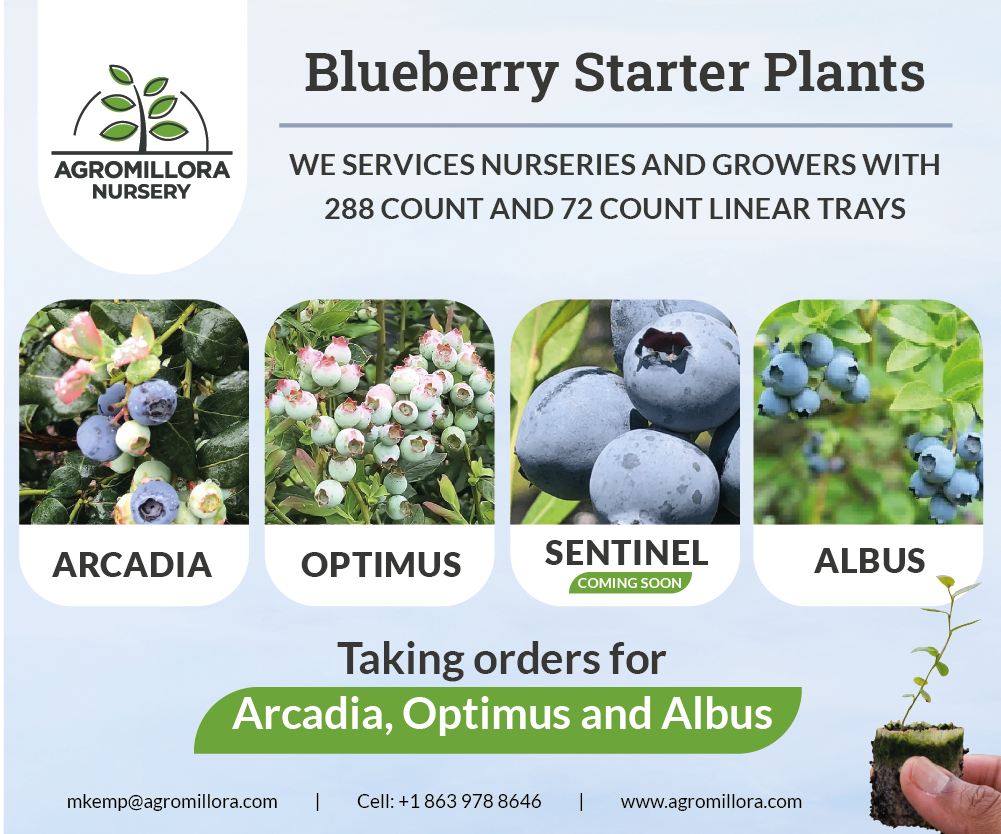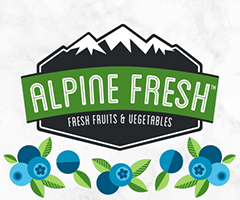Avoiding Water Stress During the Fruit Development Period
by JEFF WILLIAMSON, Extension specialist, Horticultural Sciences Department, IFAS, University of Florida Gainesville, and GARY ENGLAND, multi-county Extension agent, IFAS, University of Florida, Lake County
The fruit development period (bloom to harvest) is a critical period for optimum blueberry plant water status. March, April, and May are often dry months in Florida, and while this may be beneficial for disease control and berry quality, it emphasizes the need for proper irrigation management to avoid water stress during this critical period. Most new blueberry plantings are equipped with some type of low-volume irrigation system for routine irrigation, as well as overhead irrigation for freeze protection. This article will discuss irrigation needs other than those for freeze protection. Plant water requirements are relatively low during dormancy, but increase significantly with the onset of bloom and early shoot emergence. Under Florida conditions, a rapid increase in plant water use is typically observed between February and mid-March (depending on location, cultivar, and weather patterns) as new leaf surface area begins to develop following bloom. Plant water use continues to increase during spring as day lengths and temperatures increase, fruit continue to develop, and leaf surface area continues to increase. The final stages of fruit development are associated with a rapid increase in berry size just prior to ripening (typically occurring in April and May, depending on location and cultivar). This is a critical period for maintaining optimum plant water status during a period of relatively high plant water demand. After harvest, summer pruning that removes a significant amount of the canopy leaf surface area can result in a temporary decline in plant water use, but as the summer flush develops, days continue to lengthen, and temperatures continue to increase, plant water use will increase.
As mentioned above, the fruit development period is one of the most critical periods for maintaining optimum plant water status and it potentially coincides with dry weather in Florida. The initial stage of berry development, which begins shortly after bloom, is referred to as Stage 1 and is characterized by rapid cell division. Water stress during this period can have a negative effect on cell division, cell number per berry, and final berry size. Following Stage 1, there is a lag phase in berry growth (Stage 2), which often coincides with rapid shoot development. The plant water status during Stage 2 may not be as critical for fruit development, but may be important for strong spring flush development. Stage 3 of berry growth is characterized by rapid cell expansion and is perhaps the most critical period for maintaining a good plant water balance to achieve optimum yields. Stage 3 generally comprises the final three to four weeks before harvest. During Stage 3, the canopy is well developed, fruit growth is rapid, and plant water demands can be relatively high.
Blueberries are shallow-rooted with most of the fibrous roots in the top few inches of the soil profile, making them drought susceptible during dry weather. Because of the shallow rooting depth and low water holding capacities of typical Florida blueberry soils (pine bark amended sandy soils), most growers have found that light, frequent irrigations are most effective. Under hot, dry conditions, blueberry plants can develop drought stress after three to four days without irrigation, or possibly shorter durations depending on soil conditions, rooting depth, etc. However, the shallow root profile of blueberry limits the effective duration of a single irrigation event. Excessively long irrigation events only place much of the irrigation water below the root zone out of reach of the blueberry plants. For these reasons, some growers with drip irrigation find it useful and effective to pulse several short irrigation events per day during hot, dry periods. In order to develop an efficient irrigation schedule, it is necessary to know the location of the plant root system (particularly the rooting depth, since the lateral root spread is usually limited by the confines of the bed), the water holding capacity of the soil, critical crop growth and development stages, and weather conditions, which impact evapotranspiration. The soil’s physical characteristics, such as water holding capacity, can change over time as soil amendments such as pine bark decompose. These factors can be used to estimate crop water needs but soil moisture monitoring is important to understand if the irrigation schedule is both efficient and meeting the needs of the crop.
UF/IFAS Regional Specialized Extension Agent and Director of the Suwanee Valley Extension Demonstration Unit, Bob Hochmuth, initiated evaluations of irrigation water infiltration through the rootzone in straight bark and incorporated bark culture on some major blueberry farms in Central Florida and one in South Georgia. The images below reveal some of the results observed in the trials in a Central Florida blueberry farm. In Fig. 1, the circle indicates some water has percolated below the root zone, but a majority is still available for uptake by the roots in an eight-minute irrigation duration in a seven-year-old straight pine bark bed. Fig. 2 demonstrates that after a 13-minute irrigation cycle, additional dye has percolated beneath the rootzone. Once the irrigation water encounters the native sand below the bark, the depth of irrigation water percolation deeper into the soil slows, but the width of the blue dye pattern increases. This is typically observed in drip irrigated vegetable fields in sandy soils where the irrigation water forms an onion shape as the water-front increases.






